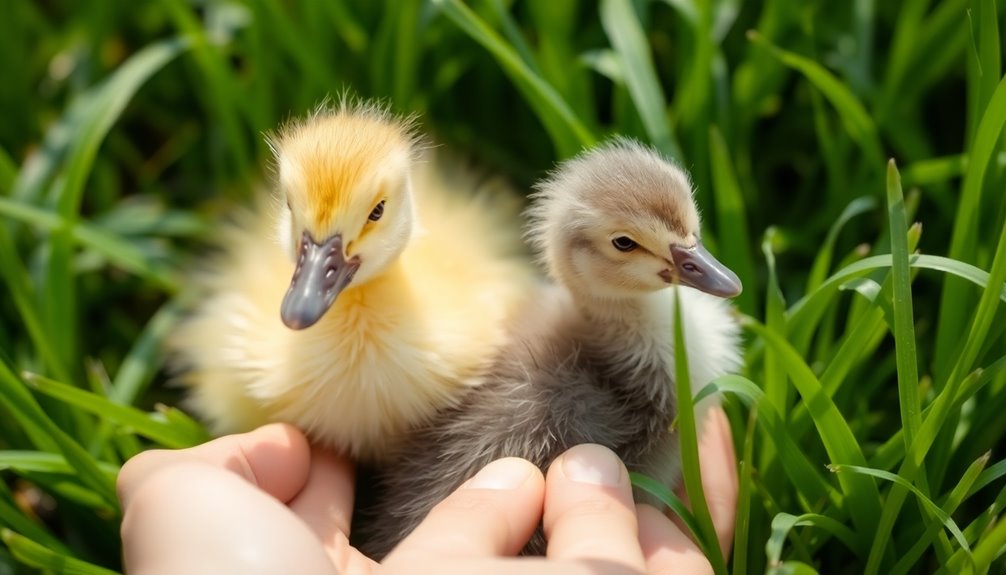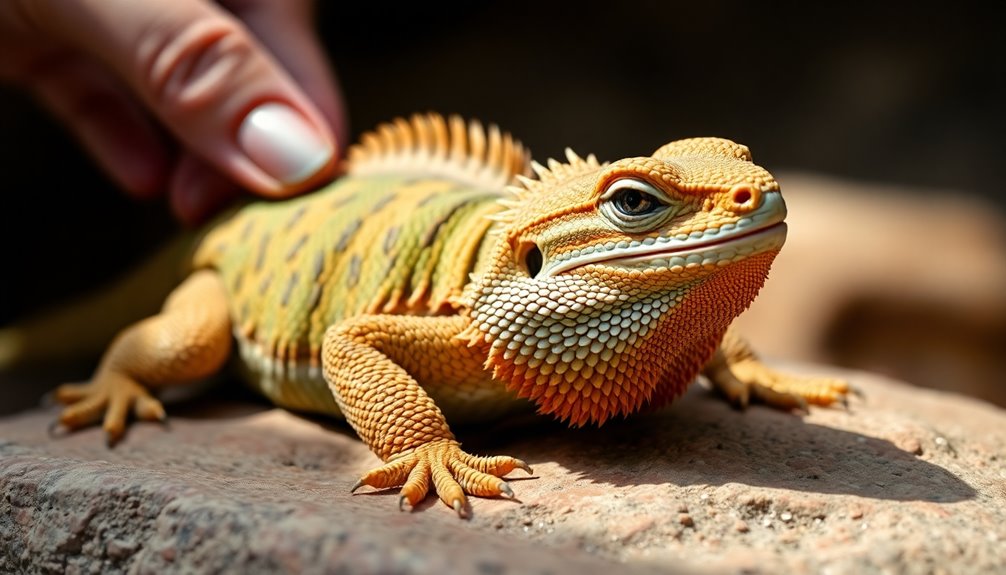To sex ducklings, the most accurate method is vent sexing, which involves checking for the male's penis shortly after they hatch. You can do this within the first few days of life. Vocalizations also help; female ducklings tend to quack loudly around two weeks, while males produce softer grumbles. As they mature, look for plumage differences; males generally have darker feathers and curled tail feathers by three months. Understanding these characteristics will help you manage your flock's dynamics and breeding plans effectively. There's much more to explore on the topic, so keep going to gain deeper insight.
Key Takeaways
- Vent sexing is the most reliable method, checking for male genitalia in day-old ducklings.
- Vocalizations can help identify sex; females quack sharply while males produce softer grumbles.
- Tail feather shape indicates sex; males develop curled feathers, while females have flat feathers.
- Plumage differences become apparent around three to four months, with males showing darker colors.
- Bill color may help sex Welsh Harlequins, where males often have a different hue than females.
Importance of Sexing Ducklings
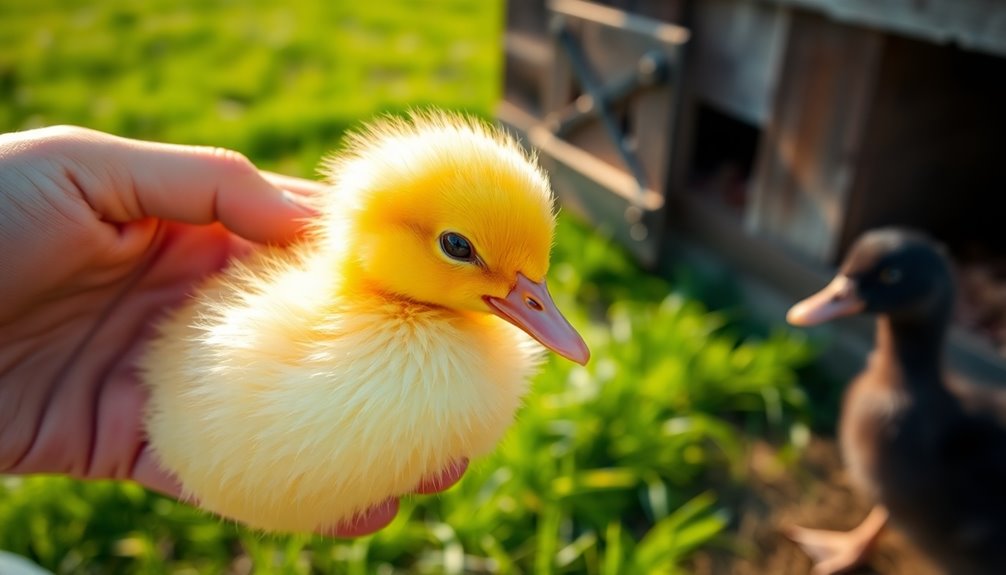
When you decide to raise ducklings, understanding their sex is vital for maintaining a harmonious flock. Accurately sexing ducklings is imperative for flock dynamics, as the ratio of males to females can prevent aggression and over-mating.
If you're raising ducks for breeding or egg-laying, knowing their sex helps you plan effectively. Without proper sex identification, mixed-sex flocks can lead to stress and injuries due to over-mating behaviors.
Vent sexing is the most reliable method for determining the sex of ducklings, especially within the first few days of life.
Methods for Sexing Ducklings

Determining the sex of ducklings can be challenging, but several effective methods can help you achieve accurate results.
The most reliable method of sexing is vent sexing, where you carefully check day-old ducklings for a penis in males.
While vocalization can aid in identifying male and female ducklings, it only becomes clear around two weeks old.
Plumage characteristics aren't useful until they develop adult feathers at three to four months.
Bill color may indicate sex in breeds like Welsh Harlequins, with males sporting darker bills.
Additionally, size and physical traits can assist; male Muscovy ducklings may grow larger and develop more pronounced features than females, especially as they approach breeding season.
Vocalization Differences
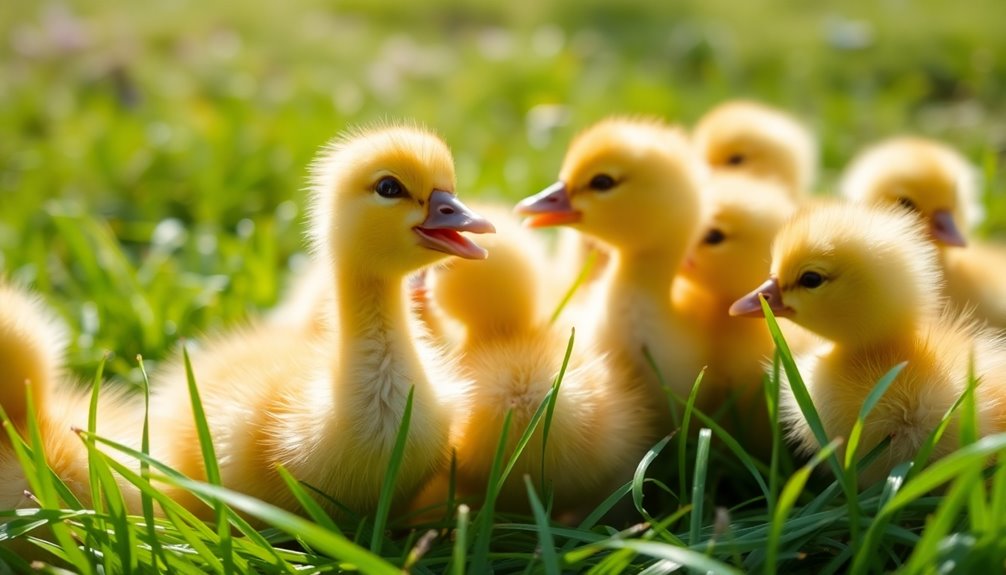
As ducklings mature, their vocalizations become key indicators of their sex. You can identify the differences by paying attention to these characteristics:
- Female ducklings start quacking around 2 weeks old, producing sharp, short quacks, often in bursts of 2 to 10.
- Male ducklings emit softer noises that evolve into monotone grumbles, shifting from peeping to raspy sounds by 8 weeks.
- Female ducklings quack more frequently and loudly as they grow, while males' vocalizations get quieter.
- Male Muscovy ducks may hiss, a sound that you won't typically hear from females.
Plumage Characteristics
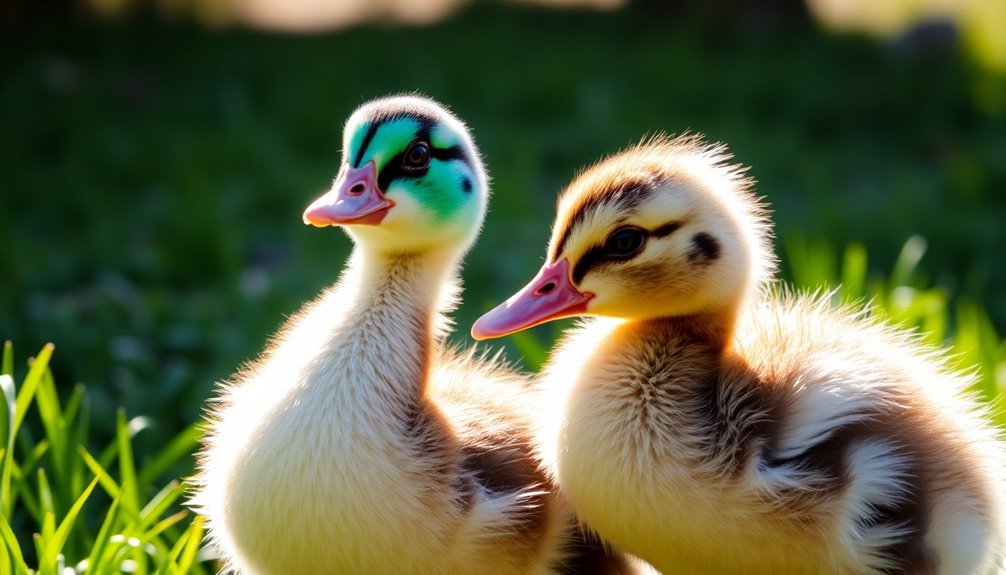
When you look at ducklings, you'll notice distinct color differences that help you identify their sex.
Males usually have darker plumage with striking black markings, while females sport lighter shades for better camouflage.
As they grow, these differences become even more pronounced, especially around three to four months when adult plumage starts to develop.
Color Differences Between Sexes
While you might be tempted to rely solely on plumage color to sex ducklings, it's essential to recognize that males and females exhibit distinct differences from a young age.
Here are some key color differences between sexes:
- Plumage Markings: Male ducklings often have darker plumage markings, while female ducks display lighter, subdued colors.
- Tail Feathers: Watch for curled tail feathers in males around 3 months; females have flat tail feathers.
- Visual Differences: Males evolve into vibrant plumage, like emerald green heads, whereas females maintain brown and gray tones for camouflage.
- Breed Variations: Some breeds, like Peking ducks, show minimal visual differences, so proceed with caution when determining sex based on color alone.
Adult Plumage Development Timeline
Understanding the adult plumage development timeline is essential for accurately sexing ducklings. Male ducklings typically start showing distinct adult plumage characteristics around 3 to 4 months, with vibrant colors emerging.
In breeds like Mallards, you'll notice bright emerald green heads and chocolate-colored chests on males, while females remain camouflaged with brown and gray feathers.
Tail feather differentiation becomes clear around 8 to 16 weeks; males develop curled tail feathers known as drake feathers, while females keep flat tail feathers.
By 5 to 6 months, adult feathering completes, solidifying visual sex differences.
Keep in mind that some breeds, such as Peking ducks, have minimal plumage differences, so vocalization and behavior become more reliable indicators for sexing.
Tail Feather Analysis
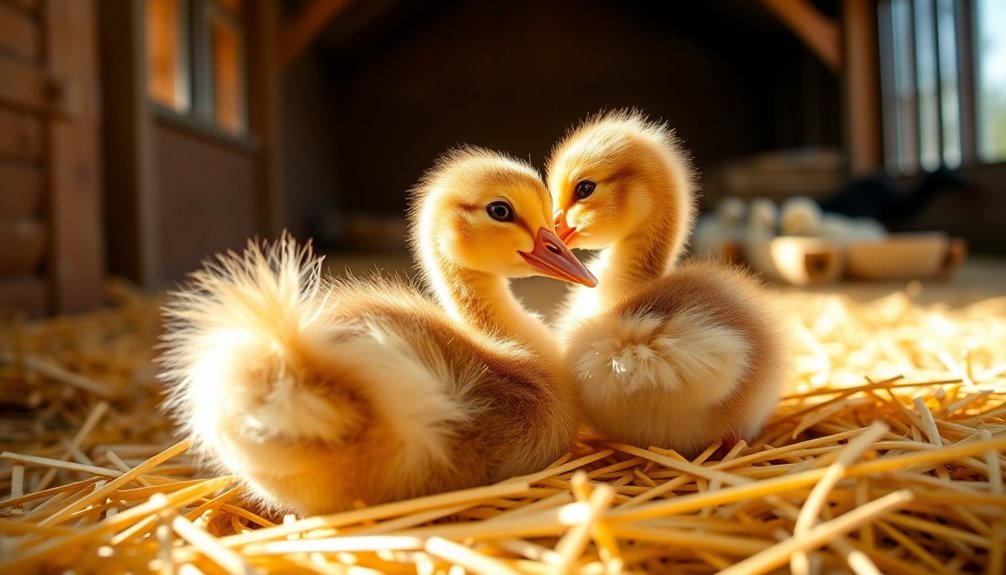
Analyzing tail feathers is a straightforward yet effective method for determining the sex of ducklings as they mature.
By focusing on tail feather shape, you can easily identify sex differences between male and female ducklings. Here's what to look for:
- Curled tail feathers: Male ducklings develop drake feathers around 3 months old.
- Flat tail feathers: Female ducklings maintain flat tail feathers throughout their development.
- Growth patterns: Observe distinct growth in tail feathers as ducklings mature.
- Combination of methods: Use tail feather analysis alongside other duckling sexing techniques for enhanced accuracy.
Vent Examination Technique
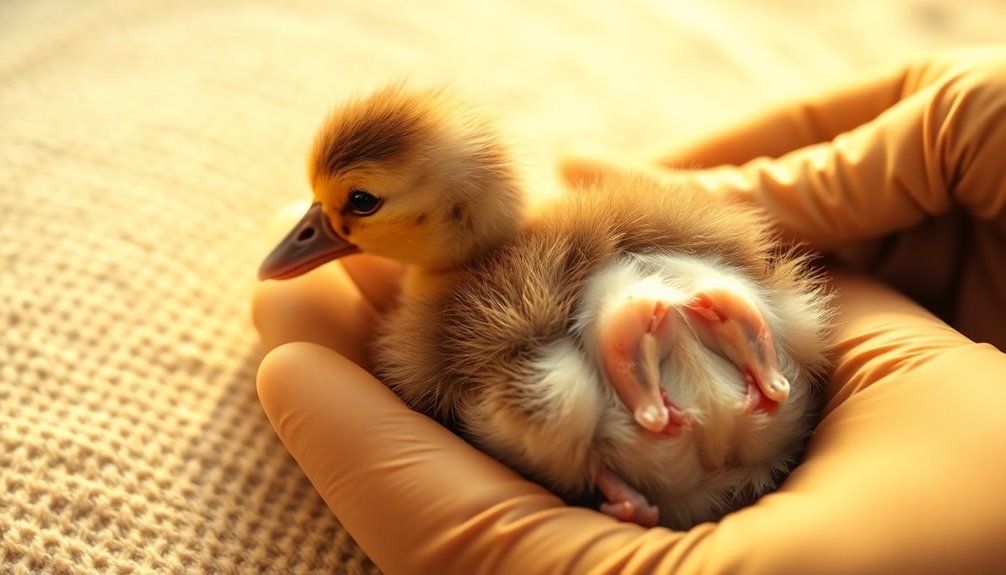
Tail feather analysis offers valuable insights into duckling sexing, but vent examination provides a more immediate and accurate method, especially in the early days of life. To perform the vent examination technique, gently hold the duckling upside down and apply gentle pressure below the vent to evert the cloaca for sex identification. Male ducklings display a corkscrew-shaped penis, while females show vaginal lips without protrusion. Keep the process quick, ideally under 20 seconds, to minimize stress. If you feel resistance, pause and reapply gentle pressure to avoid injury. This technique is most accurate on ducklings that are 1-2 days old.
| Duckling Sex | Physical Characteristic | Examination Notes |
|---|---|---|
| Male | Corkscrew-shaped penis | Quick examination needed |
| Female | Vaginal lips without protrusion | Gentle pressure required |
| All | Avoid forceful manipulation | Minimize stress |
| 1-2 Days Old | Best time for examination | Most accurate results |
| Older Ducklings | Possible but requires care | Practice enhances skill |
Community Insights and Resources
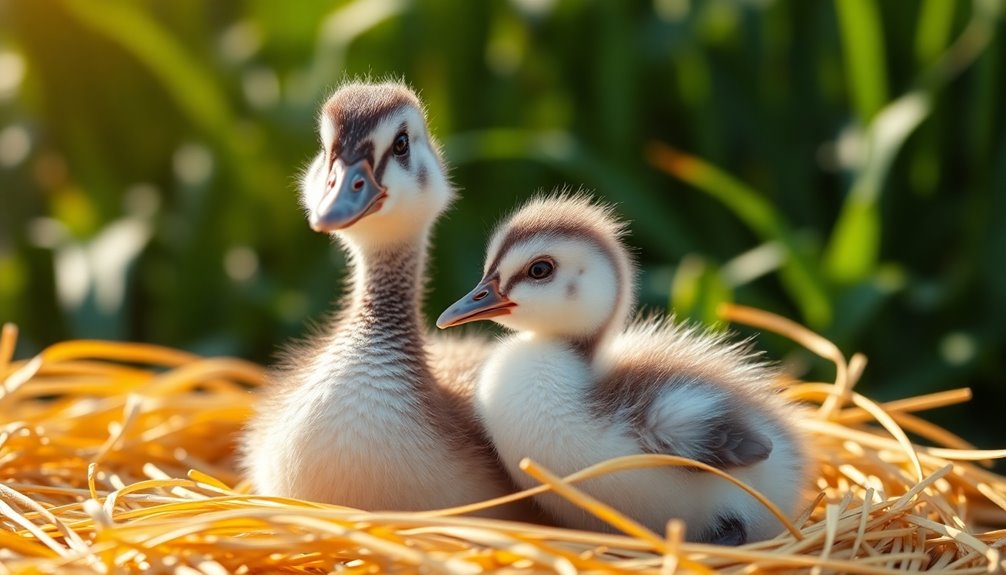
Many duck owners find that engaging with online forums and communities can be incredibly helpful for sharing personal experiences and successful sexing techniques.
Here are some ways to gain valuable community insights:
- Document Vocalization Changes: Track calls over time to help identify male and female ducklings.
- Learn Breed-Specific Traits: Understand unique characteristics that may assist in sexing your ducks.
- Utilize Online Resources: Explore videos and articles detailing the vent sexing process and other identification methods.
- Participate in Q&A Sessions: Join discussions in duck care communities to clarify misunderstandings about sexing techniques.
Frequently Asked Questions
How Do You Tell if a Baby Duck Is a Boy or Girl?
To tell if a baby duck's a boy or girl, you've got a few options.
Listen closely; females start quacking around two weeks old, while males have softer, raspier sounds.
Check their plumage—males often show darker markings.
You can also look at their bills; in some breeds, males have darker bills.
Finally, observe their tail feathers; males develop curled tails around three months, whereas females keep theirs flat.
What Age to Vent Sex Ducklings?
When you're trying to determine the right age for vent sexing, timing is everything.
You'll want to perform this delicate process when ducklings are just 1 to 2 days old. At this age, their cloacal openings are more accessible, making it easier for you to interpret their sex accurately.
Waiting too long can complicate things; after 3 weeks, distinguishing the sex becomes much harder.
How Do You Tell if a Duckling Is a Drake or Hen?
To tell if a duckling is a drake or a hen, you'll notice vocal differences; drakes make softer, raspier sounds, while hens quack sharply.
As they grow, check their tail feathers—drakes develop curled feathers around three months, while hens keep flat ones.
Look for plumage variations too; drakes often have brighter colors and distinct patterns compared to the more subdued hues of hens.
How Do I Identify My Ducklings?
To identify your ducklings, observe their vocalizations and plumage.
By around two weeks, you'll hear sharper quacks from females and softer, raspier sounds from males.
Look for distinct markings or brighter colors; males might show these traits.
As they grow, pay attention to their tail feathers—curled ones indicate males.
If you're comfortable, you can also check their vents for a more definitive identification.
Size differences will become clearer over time, too.
Conclusion
To sum up, knowing how to sex ducklings is essential for managing your flock effectively. Curiously, studies show that about 60% of ducklings can be misidentified without proper techniques, leading to unexpected male-to-female ratios. By utilizing vocalization differences, plumage traits, and vent examination, you can confidently determine the sex of your ducklings. This knowledge not only helps in breeding decisions but also enhances your overall experience as a duck keeper. Happy duck raising!

